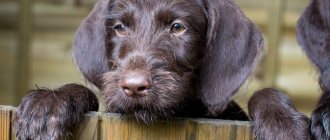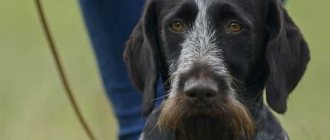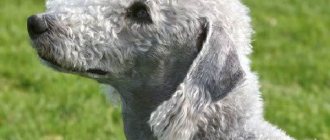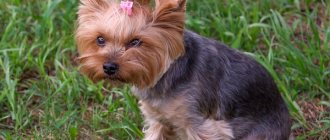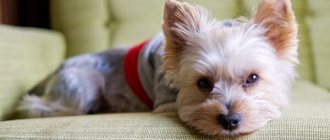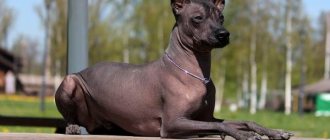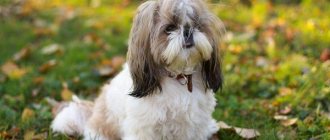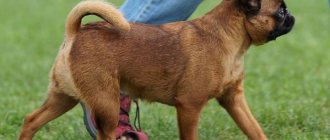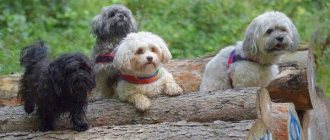- Drathaar
The Drathaar is a large hunting dog breed with a harmonious build. A dog with excellent working qualities that can withstand any bad weather and physical activity.
- Country of origin : Germany
- Height at withers : male: 61-68; female: 57-64 cm
- Weight : 23-32 kg
- Lifespan : 12-14 years
- Use : Hunting, Companion Dog
- Other names : German Wirehaired Pointer
Purchasing a Drahthaar puppy is a responsible and important act that you need to think carefully about before doing. This is especially true for those people who are going to become truly responsible dog breeders. The question of choice should be approached carefully and without haste, comparing your own habits, daily routine and the nature of the chosen breed. When the future owner has decided on the breed, a new dilemma arises: how to find a bona fide breeder? Here you need to be extremely careful not to become a prematurely disappointed dog owner.
Buying a Drahthaar puppy is a very exciting event, because you can say that a new family member will appear. To ensure that the event does not overshadow anything, it is worth taking a responsible approach to choosing a breeder. There are no bad dog breeds; you can simply run into an unscrupulous breeder for whom money comes first. The future owner is at great risk of buying an animal that has a lot of health problems. It is for this reason that you need, first of all, to get to know the breeder well, read reviews about him and the like.
Features and description
The Drathaar dog is an ode to the old German ones. Its name literally translates as wire wool. It is so tough that it actually feels like wire. This is the basic feature of the animal. It does not get wet in water. This is a huge advantage, thanks to which the dog can be used to catch waterfowl.
Its fur is very dense, so twigs, sharp leaves and branches do not interfere with maneuvering in forest areas. Also, the presence of hard protective fur makes it easier for the dog to crawl into places where a person cannot physically penetrate.
This is a very effective and skillful hunter! Most professionals train drathaars to catch large animals. They bark loudly, warning the victim of its fate. Bloodthirstiness is not characteristic of these dogs, but determination is. If they are on the trail of prey, it can no longer hide. They quickly identify the smell of different animals and distinguish them well.
Most professional hunters use such dogs to search for wounded game. By nature, they are endowed with an excellent sense of smell, which “leads” them to the desired smell. Thus, the drathaar can easily track down a wounded doe, an injured deer or a wild boar.
He will run to the beast before the man, but will not kill him. This mission rests entirely with the person – the owner. But these are not all the features of the representative of the breed. It is unique in its well-developed sense of territoriality. Not every hunting dog has it.
What benefits does this feeling give the dog? Its presence indicates protective qualities. Yes, the drathaar can serve as a watchman in the house. But he is an ineffective bodyguard.
This animal is not endowed with natural aggression, therefore, most often, it treats parishioners loyally and friendly. However, he will not allow anyone into his territory if there is no owner on it. Many will be surprised, but these talented hunters are also good shepherds.
Yes, yes, their hunting instinct does not apply at all to sheep, goats, cows and other farm animals. Drathaar will obediently guard the herd and responsibly monitor each animal from it. Many shepherds keep it precisely for this purpose.
Today there are many clubs in the world where breeders of these amazing dogs exchange professional experience regarding their upbringing, feeding, maintenance, etc. People love them for their kindness, passion and good working qualities.
How to choose a puppy
- Before you start choosing your future pet, visit a club or breed section that controls the breeding activities of nurseries to get complete information about matings and the true titles of the puppies’ parents.
- If the puppy you like has a weak mustache and goatee, it is better to postpone the purchase for several months. Perhaps after some time the fur on the face will grow. If this does not happen, abandon the baby, since such a pet will not pass “face control” at any exhibition.
- Those planning to purchase a capable hunter should inquire whether the puppy's parents have relevant experience. The best option is a baby from a bitch and a dog who have at least two diplomas in swamp and field game.
- Watch how the Drahthaar puppy behaves in the pack. Give preference to curious individuals trying to dominate their fellows.
- Inexperienced owners are better off choosing girls. They are more contactable and pliable. Drathaar males are more stubborn and independent, they need a strict and self-confident mentor.
Breed standard
The Drathaar breed is medium in weight and size. The height of females is 52-55 cm, and that of males is 58-61 cm. The average weight of such a dog is 35 kg. Permissible weight, according to the standard, is 40 kg. More massive individuals are considered overweight and are disqualified from competitions or exhibitions. By the way, excess weight can significantly reduce the working potential of an animal.
Purebred representatives of the breed should have a wide, rectangular back. According to the standard, it should fall slightly towards the lower back. The dog's tail is docked and is quite thick.
Her withers are wide, her loin is convex. The neck is elongated and has no dewlap. The muscles on the sternum are well developed. This part of the dog’s body is deep and slightly narrow (a wide chest in hunting dogs is a pathology). The peritoneum is tucked up, without dewlap. Paw placement is parallel. The angles of the joints on them are clearly defined. The toes on the oval paws are pressed tightly together. Their pads are very hard.
The sides of the skull are slightly convex. The head is medium in size. The dog has a very pronounced transition from the middle of the forehead to the lips and nose. He has a strong jaw. The bite is scissor-shaped. A complete set of white triangular teeth. The shade of dry lips is dark, almost black.
Drathaar looks smart and interested in the photo. This is due to the special shape of the eyes. They are set quite deep, have a color similar to fur and are covered by a fold of skin on top. The standard allows for slight pigmentation of the eyes around the edges. The large ears, located high on the top of the head, hang down. Their ends are rounded.
Outwardly, this dog gives the impression of being strong and healthy. This is true. Her physique is powerful and strong. The fat layer is practically absent in the drathaar. This allows him to move expansively but elegantly, jump high and run fast. Its ribs are wide, rounded, and accommodate voluminous lungs. This feature of the dog’s physique indicates its good endurance.
Peculiarity of the breed! This beautiful four-legged hunter has long hairs growing in different directions on the edge of his muzzle. Therefore, it seems that he has a mustache or a short beard. The drathaar's fur is of medium length. It is short on the muzzle, tail, abdomen and paws. Acceptable colors:
- Pure black (very rare).
- Coffee.
- Chocolate brown.
- Coffee with specks.
- Black and silver.
Appearance of the breed
The size of the animal is classified as maxi (large dogs). Height at the withers is about 60 cm, males are slightly taller than females. Weight from 23 to 32 kilograms.
- The dog's head is elongated, with a pronounced forehead and strong jaws.
- Due to the presence of a mustache and beard, the muzzle appears rectangular.
- The ears are hanging, oval in shape, slightly narrowed and rounded at the tips. The eyes are slightly slanted.
- Coarse wool was not bred by breeders for the sake of external distinctive features.
- This type of coat protects the dog from insect bites, minor injuries and cold.
The photo of the drathaar shows that the animal has prominent, strong muscles. Muscularity is combined with the overall gracefulness and agility of the breed. The tail is docked as standard.
There are several varieties of drathaar color: black and piebald, silver-gray, coffee and coffee combined with gray or silver.
Character
Guess what becomes the master of the drathaar? Of course, the person involved in his upbringing and socialization. Most often, this is a male hunter. The animal becomes strongly attached to its owner and never betrays him. Even if there are guests in the house, it will remain sitting at his feet.
Such a dog can well be called temperamental. She is moderately intrusive, calm and patient. I am not prone to violent manifestations of emotions. Needs an emotional connection with pack members. She gets very upset if they ignore her.
Gets attached to everyone quickly. He expresses his love simply - by the method of “following on his heels.” He prefers to be near his owner, but if he is not at home, he goes to other people. Sincerely becomes attached to every member of the household.
This hunting dog has a cute nickname - “house sitter”. They called him that because of his love for children. He adore kids of different ages and genders. The animal enjoys playing with them, walking and just relaxing.
It is always responsible for a child who has been left unattended by adults. He doesn’t allow him to leave the playpen or get off the sofa, because he understands that he could hit or hurt himself.
These are not at all aggressive animals. But we said above that they make good guards. How is this connected? It's simple. Drathaar is a temperamental and adequate watchman. He will not attack a stranger or injure him, but he will definitely bark at him, which will scare him away. By the way, their bark is very loud.
This is an easy-going dog with a penchant for obedience. Learns easily and quickly. It is important for her to please her beloved owner and make him laugh. To do this, he will obey and learn all the household rules. Her intellect is excellent. I hate loneliness. Moreover, he is even afraid of him.
Interesting! Some people believe that dogs are endowed with a phenomenal ability to intuitively sense their owners. So, they are always sad if they face a long separation.
Relationships with people are built in different ways. If he likes a person, he will greet him warmly; if not, he will ignore him or openly reject him. He becomes attached only to those who sincerely sympathize with him. Sensitive to affection.
But he is often hostile towards adult dogs. This is typical for most hunting breeds. Can conflict with any dog prone to dominance. For this reason, you should not get an adult drathaar if you already have dogs in the house. Exception: you are a professional dog handler and know how to resolve conflicts that arise in a dog pack.
Temperament and psychology
Among lovers of the breed there are many who have an animal as a companion. The description of the Drathaar breed is of interest to athletic people accustomed to an active lifestyle. Energy and agility are harmoniously combined with the calm disposition of the animal.
- Despite the dog’s complaisance and good nature, dog experts advise training your dog from puppyhood and paying a lot of attention to the process.
- The dog is stubborn and willful; if it does not recognize its owner as a leader, it can become disobedient.
- The breed has a tendency towards possessiveness and jealousy, which can also be corrected with a competent dog handler.
Despite the gentle, non-aggressive disposition, the pet is a wonderful watchman.
In a dog pack, the drathaar chooses leading positions and does not agree to put up with second roles. He gets along well with children and will be a great friend for a teenager.
Maintenance and care
A hunting dog requires frequent walks. She will have to devote at least 4-5 hours a day. It is better to start it if you live in a house. But apartment maintenance for the drathaar is also provided.
Take him out into the fresh air every day. This is required so that the dog:
- Improved my health.
- Relieved himself.
- Sniffed the area.
- I gained new emotions and impressions.
- I played the role of a researcher.
- I talked to people like myself.
By the way, about the last point. Poorly trained hunting dogs often bully other animals while walking. The fact is that during the day they accumulate a huge amount of energy that needs to be released.
If a big cocky dog meets on the way of a drathaar, he will definitely not be afraid of him, but may show aggression and attack. To exclude this scenario, teach the animal to be obedient from childhood. Switch a pet that is fixated on some animal using the “Fu” command.
A hunting dog kept at home should be brushed regularly with a massage brush. An alternative is a slicker. During the molting season, which occurs in the warm season, its thick undercoat dies off, so it remains everywhere.
Cleaning it is unpleasant and problematic, therefore, it is better to brush your pet daily throughout his life. First of all, this applies to those who live in the apartment with him.
Advice! The thick fur of a drathaar can only be combed with a metal tool. But when doing the procedure, do not damage the animal’s skin.
Healthy teeth are extremely important for a hunting dog. They need to be constantly monitored:
- Treat in time.
- Remove plaque.
- Remove tartar.
- Brush.
We recommend periodically inspecting the animal's mouth for damaged teeth. Ideally, they should always be snow-white and sharp. The animal's face also requires care. Dirt constantly accumulates on his beard, especially after eating. It is better to remove it with plain water.
Some drathaar owners prefer to trim their pet's "whiskers" so that they don't constantly get dirty. This definitely makes sense. However, a lover of a dog’s exotic appearance will definitely not come to such a decision.
Character of the drathaar
German Wirehaired Pointers are 80% hunters and only 20% pets. Like true workaholics, these restless “bearded men” are ready to travel for days in the company of their owner through forest clearings and swamps in order to take possession of the coveted trophy. And this is not surprising. The breed is primarily ruled by hunting instincts, which must be given vent. Deprived of the opportunity to run after the coveted game or even a field mouse, the animal soon turns into a pale shadow of itself. So, if you don’t particularly like hunting and forays into wild places, there is no point in getting a drathaar.
Representatives of this breed are suspicious and slightly distrustful of strangers, so it is easy to “retrain” wire-haired cops as watchmen. By the way, they also make good companions. Drathaars do not offend children, willingly playing tag and other active games with them. If it is not possible to take the animal for a full walk, leave it for an hour with the baby, who will be happy to “load” the dog with a variety of physical exercises.
Among the main advantages of the breed, Drahthaar owners usually note the lively intelligence, diligence and responsibility of its representatives. Wirehaired pointers very sensitively sense the mood of the owner and are well aware of what is wanted from them. The only drawback that can cause mutual misunderstanding between a dog and its owner is the animal’s innate desire for dominance. Having a fairly friendly character, these bearded hunters are not at all averse to crushing a person under themselves, turning him into the fulfillment of his own desires.
Nutrition
Such an animal eats a lot, because it spends most of the day on the move, as befits a purposeful four-legged hunter. The normal dose of food for him is 600-700 grams. Adult representatives of the breed can be fed both natural food and professional food. But, the Drahthaar puppy needs to be given daily:
- Boiled chicken eggs.
- Buckwheat seasoned with butter.
- Chopped meat.
- Milk.
- Puree of fruits and vegetables.
- Soups and borscht (low-fat).
You should not feed your baby sweets, as this will cause him nausea and flatulence. It is just as undesirable to give him a lot of bones with streaks of meat, in fact, as it is for an adult. You can pamper your pet with a canine delicacy, such as dried bull penis. It is sold at zoological markets or pet supply stores.
Drathaar's Health
The weak points of the drathaar are the intestines, bones and skin. Some representatives of the breed suffer from hip or elbow dysplasia.
If an animal's bones develop abnormally, over time this can cause lameness, arthritis, and pain in the paws.
- Intestinal volvulus can happen if a hearty lunch with plenty of drink is suddenly replaced by active training and vigorous walks. Symptoms: Bloated stomach, urge to vomit, depression. The problem is typical for older animals. Without medical attention, the disease can be fatal.
- Skin diseases are most often associated with allergies. The cause may be diet, insect bites, pollen, or plant sap. Symptoms: itching, swelling, skin rash, hair loss, sneezing. Allergies are treated by relieving symptoms until it is determined which allergen is causing the unpleasant condition.
Reproduction and lifespan
It may sound trivial, but the lifespan of a domestic dog depends entirely on how well it is cared for. Healthy drathaars can easily live up to 15-16 years. Their average life expectancy is 13 years.
The age of puberty in males is 5-6 months. In bitches it is somewhat later, starting from 8-10 months. However, they cannot be knitted at such an early age. Young dogs certainly will not produce healthy offspring.
Before crossing high-breed Drahthaars, the breeder must raise them to at least 2 years of age. At this age, dogs have already learned obedience, are adequate in terms of expressing feelings and are physiologically mature.
A pregnant bitch will give birth around 70 days from the start of mating. One litter can have from 1 to 12 puppies. You should choose ones that are nimble, agile and loud. The puppy should be separated from its mother-bitch no later than 1 month after its birth.
Choosing a Drathaar puppy
When wondering where to buy a drathaar dog, it is important for the future owner to decide on the motives for buying the animal. If the dog is expected to be used for hunting, it is better to take a puppy from working parents who have proven themselves well in this area.
- For a pet, hunting qualities are less important - you can choose it less pickily.
- However, even when buying a puppy for your soul, you should still contact trusted nurseries.
- Officially registered breeders value their reputation and do not allow improper crossbreeding in breeding.
The price of a drathaar with documents is more expensive, but they are a guarantee that the pet will grow up healthy, without severe heredity, and will please its owner for a long time.
Price
If you are a true connoisseur and fan of hunting, then you should go to his homeland, that is, to Germany, for a “professional” four-legged friend. Fortunately, there are many drathaar nurseries there. Experts will help you make a choice and tell you about methods of feeding, training and keeping the animal.
The price of a drathaar brought from Germany is from 500 euros. The future owner must also take into account the costs of transporting the animal or traveling to pick it up. This purchase can cost at least 1000 euros.
For those who love hunting, but do not plan to spend a huge amount of money on an assistance dog, much less go to another country for one, you can use the services of one of 3 Moscow kennels. Thoroughbred representatives of the breed are sold there from 25 to 40 thousand rubles.
Drahthaar nurseries
| Nurseries | Federation | City |
| Kennel "... from Anna's Empire" | RFOS | Kaliningrad |
| Nursery “Iz Druzhina Peresvet” | RFSS | Bryansk |
| Nursery BELIE ROSY | RFSS | Moscow |
| Kennel GLORIOUS HUNTER | RFSS | Velikiy Novgorod |
| Nursery Call of the Fields | RFOS | Moscow |
| Nursery From the Northern Capital | RFLS | Vsevolozhsk |
| Nursery SNOW ADVENTURES | RFSS | Moscow |
| Nursery Steppe wide | RFSS | Volgograd |
| Kennel ACTIVE LIFE | RFLS | Balashikha |
Source - https://rkf.online/organizations?organization_type=3&active_rkf_user=false&activated=false
For more information, see the official website of the RKF.
Education and training
The intelligence of these beautiful hunting dogs is very good, so they grasp everything, as they say, on the fly. You can learn standard commands for four-legged pets, such as “sit,” from the first months of meeting your dog.
It is very important to train him to react correctly to a shot! It is better to seek help from a professional if you plan to regularly go hunting with your dog. First, she should not be afraid of guns and death.
If a creature acts restless at the sight of a rifle, it is likely a non-purebred drathaar. Secondly, she should not take off as soon as she hears a shot. She should wait for the command of the owner, who is in control of the situation.
The dog’s psyche is such that it instantly switches attention from one object to another. For example, if you teach him the “down” command, and a cat runs nearby, he will probably want to catch up with it.
Keep your pet interested so he doesn't get distracted! You must be able to snap your fingers loudly. Focus your inquisitive dog's attention on you every time you teach him something. If she turns away from you or becomes interested in something, make a loud snap with your fingers.
To strengthen your bond with your pet, go out with him to the stadium or forest for joint training. You can run cross-country together, swim in the river, or just play fetch a stick. The hunting dog will enjoy active recreation. Never forget to take it with you on an outing!
Several traditional prohibitions for a domestic dog:
- Shared meal with household members.
- Intrusive behavior with guests.
- Aggression towards strangers.
- Bullying behavior with dogs or any other animals.
- Food aggression.
- Arriving at an area reserved for people.
This is just the beginning list of prohibitions. Experts also strongly advise against allowing large dogs with coarse fur to sleep with people. Firstly, it dismoralizes them and makes them less disciplined. And secondly, it is not hygienic.
More about hunting. When you plan to regularly engage in it with your pet, you should not forget about the need to systematically establish a relationship with him. Psychological contact with the owner is as important for the drathaar as physical contact. It is important for him to know that the owner loves and appreciates him. This is the only way he will be socialized correctly.
A dog grows up to be responsible and purposeful only if it grows up in an atmosphere of friendliness and mutual understanding. If you regularly raise your voice at a puppy of this breed, offend him or even beat him, he will grow up unsure of himself and fearful.
An owner who is rude to a drathaar will likely experience disobedience and perhaps even aggression. Therefore, you should build a trusting relationship with the puppy as soon as he crosses the threshold of your home. In the first days of his new life stage, surround your pet with care. This will help him gain confidence and become attached to you.
Breed characteristics and character
Before describing the German Drahthaar , it is worth clarifying other breeds ending in "Haar". In the world, the Drahthaar is called the German Wirehaired Pointer. Short-haired pointers are shorthaired pointers, long-haired ones are langhaars. All dogs are related and come from the same breed.
Drathaar is waiting for its owner
Nowadays, the drathaar is considered a relative of the cops who lived long ago in Germany, as well as in Switzerland and France. Dog handlers came to the conclusion that the drathaar came from a mixture of the blood of hunters and hounds from all three countries. Today, the Drahthaar is a hunting dog that can also be a domestic companion.
A special feature of the animal's appearance is its funny beard and mustache. In the old days, the breed was considered a “bird breed”, that is, dogs hunted birds. The Drathaar began to be considered a field dog at the end of the century before last, when it demonstrated its specialized qualities.
Tests in the fields have proven that these four-legged animals are promising. This is where systematic breeding work originates. The first breed standard was adopted in the 20s of the 20th century. However, by the beginning of World War II, breeding of individuals ceased, and the livestock was significantly depleted.
After the war, German, Austrian, and French breeders tried to restore the population. The work lasted almost 20 years, and the emphasis was placed on the hunting qualities of the dog.
Today, the drathaar is considered a domestic companion and can also be used as a gun dog. But hunting with a drathaar is only possible if the dog has completed several courses of training and education.
Drathaar in the meadow in summer
Animals have remarkable intellectual abilities, good memory, but have their own opinions, which border on stubbornness. This dog cannot be called a sofa dog. The dog will constantly test the strength of its owners and test their patience until it grows up.
There is an opinion that a dog is prone to dominance, but dog experts assure that if it is raised, then there will be no struggle for leadership. However, in order to raise a dog, you need to fulfill two conditions - do it systematically and from the puppyhood.
The dog loves long walks, does not like loneliness and separation from family members, is loyal to its owners and gets along well with children. Doesn't always find a common language with other pets; there are jealousies among drathaars. A sensitive attitude towards your dog will help avoid misunderstandings.
Possible diseases and methods of treating them
Drathaar is a beautiful and strong dog from a group of hunting cops. He has a strong immune system, which, unfortunately, cannot be said about his joints. Yes, these dogs often suffer from dysplasia. The reason for this is their regular mobility and complex maneuvers.
Doctors often diagnose four-legged hunters with dislocated or broken paws. In this case, their mobility should be limited. Surely the owner of the injured dog will have to take him to the clinic, where he will be given painkilling injections.
Representatives of the breed are also prone to diabetes, dermatitis, ear and eye diseases. Regular grooming of your dog will help minimize the risk of disease. For example, to prevent her ears from becoming inflamed, wipe them with wet cotton wool to remove wax. You also need to wash the animal’s face weekly to remove stains under its eyes.
Parasites such as fleas, ticks and worms significantly worsen the quality of life of an animal. You must always fight them. Fortunately, there are a lot of drugs that quickly destroy them. Before prescribing medications for your pet, we recommend consulting with your pet's veterinarian.
Possible diseases
Drathaar is a dog of not very good health. Therefore, before getting a puppy, breeders recommend that you familiarize yourself with the list of diseases characteristic of this breed. It should be added that this list is impressive and covers almost all organs of the animal. You should be especially careful about your eyes and skin.
Among ophthalmological diseases, dogs most often suffer from cataracts, entropion, and retinal atrophy. In the early stages, drug treatment can help, but if the disease is advanced, surgery cannot be avoided.
Drahthaar puppy
Among the skin diseases characteristic of the Drahthaar breed , there are various types of dermatitis, including such a rare one as interdigital (pododermatitis). Weeping eczema and licked granuloma, that is, inflammation, may occur. Slightly less common are mastocytomas - malignant tumors on the skin, as well as melanomas.
Since the Drathaar is considered a large animal, like other representatives of large breeds, it may have problems with joints. The most common is hip dysplasia.
Endocrine disorders are common, for example hypothyroidism, associated with insufficient thyroid function, as well as diabetes, which occurs due to malfunctions of the endocrine and immune systems.
Sometimes a dog may suffer from otitis media, an ear disease common to many breeds with floppy ears. From time to time the dog suffers from bloating, and sometimes even volvulus occurs. In this case, it is important to suspect the disease in time and call a doctor.
How much does a drathaar cost?
You can buy a Drahthaar puppy in Russian nurseries for 20,000 - 25,000 rubles. If the baby’s parents have working (hunting) diplomas, its cost automatically increases: on average, price tags for such individuals start from 30,000 rubles. The most economical options are offered by free classifieds sites. Virtual sellers, of course, do not give guarantees regarding the purity of the breed, but you can buy drathaars from them at very tempting prices: from 4,000 to 7,000 rubles.
source www.lapkins.ru

